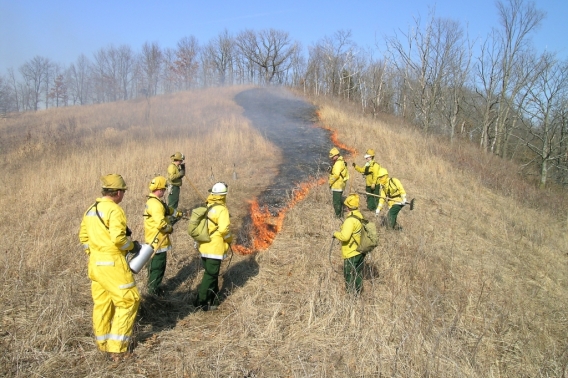Conservation Opportunity Areas and Actions
Wisconsin Wildlife Action Plan
- Conservation Opportunity Areas
-
Conservation Opportunity Areas (COAs) answer one of the questions most frequently asked by landowners and organizations that want to help Species of Greatest Conservation Need (SGCN) and their habitats—where?
COAs are aquatic and terrestrial sites with significant ecological features, natural communities or SGCN habitats for which Wisconsin is responsible for protecting and conserving when viewed from a global, continental, upper Midwest regional or state perspective. They are some of the best places in our state to implement conservation actions described in the Wisconsin Wildlife Action Plan (WWAP).
Get started
The state has opportunities to protect or restore habitat for Wisconsin's SGCNs. The COAs are mapped within Wisconsin's ecological landscapes, sixteen areas with different environmental attributes and management opportunities. They can be used to identify the state's best places to manage other natural communities, critical habitats, aquatic features, and native plants and animals from an ecosystem management perspective. In addition to a species' probability of occurring in an ecological landscape, species have different levels of association with other natural communities that may be found in that landscape. For example, the Karner blue butterfly is highly associated with oak barrens but is only moderately associated with sand prairie.
Understand your site's potential for conservation.
- Discover if SGCNs and high-quality natural communities are present on your property using one of the tools for accessing Natural Heritage Inventory (NHI) data.
- Learn more about the species, natural communities, management opportunities and sites of ecological significance within your environmental landscape.
- Use the WWAP document and map collection to:
- Locate COAs near you using the COA maps and learn about their ecological significance;
- understand how COAs were identified and what ecological priorities are found within each ecological landscape using the COA chapter in the plan;
- remember necessary conservation actions to implement for the SGCNs and natural communities on your property using the threats/issues and conservation actions documents; and
- calculate ecological priorities for SGCNs, natural communities and ecological landscapes via the association score dataset downloads.
- Conservation Actions
-
Conservation actions were identified in the Wildlife Action Plan to address issues or threats which adversely affect SGCN or their habitats. Besides on-the-ground activities, such as restoring wetlands or planting resilient tree species in northern communities, research, surveys and monitoring are also in the plan because a lack of information can hinder our ability to preserve and care for our natural resources successfully.
Conservation actions are:
- entirely voluntary;
- not a wish list, they are the most critical issues to be addressed over the next 5 to 10 years;
- clear in intent, scope and scale;
- directed at the source of the problem (sustainable construction) or its effect (restoring shoreline vegetation); and
- It is aligned with a globally recognized classification system of threats and conservation actions, making communicating easier across disciplines and regions.
Issues and conservation actions most frequently found in the WWAP
Although all problems, threats and conservation actions described in the WWAP are a priority, the following apply to the most significant number of species and habitats.
Issue: Invasive and disease-causing species.
Actions: Awareness and education about and use of multiple, integrated methods and best practices to prevent and control these species in all environments; continued research and monitoring.Issue: Habitat loss, fragmentation and degradation originating from multiple development and resource use sources.
Actions: Practices to avoid and minimize loss or fragmentation of habitat; policy and conservation planning supportive of conserving SGCN habitat; comprehensive management of protected and preserved areas to maintain and restore diverse communities and habitats; incentives to encourage conservation on private lands.Issue: Modification of environmental processes that includes water extraction and hydrological change, alteration of natural fire regime and habitat modification.
Actions: Policy and best management practices supportive of conserving SGCN habitat; comprehensive management of protected and preserved areas to maintain and restore diverse communities and habitats; incentives to encourage conservation on private lands.Issue: Unsustainable resource use for terrestrial SGCNs and their habitat and water pollution for aquatic SGCNs and habitat.
Actions: Support and compliance with best management practices and conservation planning to manage diverse habitats to persist on landscapes mixed with these other uses and improved awareness, training and education to increase compliance with existing regulations, standards and practices.Actions supporting training and participation through citizen-based monitoring and science are beneficial to the research and information needs of all species and communities. They are not limited to any single issue/threat.
Monitoring and effectiveness measures
State wildlife action plans address monitoring from two perspectives. The first is monitoring SGCNs and their habitats to track their status or condition. The second is to monitor the effectiveness of conservation actions to understand if they have the desired outcomes. When conservation actions are unsuccessful, it is essential to know why and adapt them to new information or changing conditions.
Along with SGCN and habitat, issues/threats, conservation actions, and effectiveness monitoring comprise the core of the Wisconsin Wildlife Action Plan.

